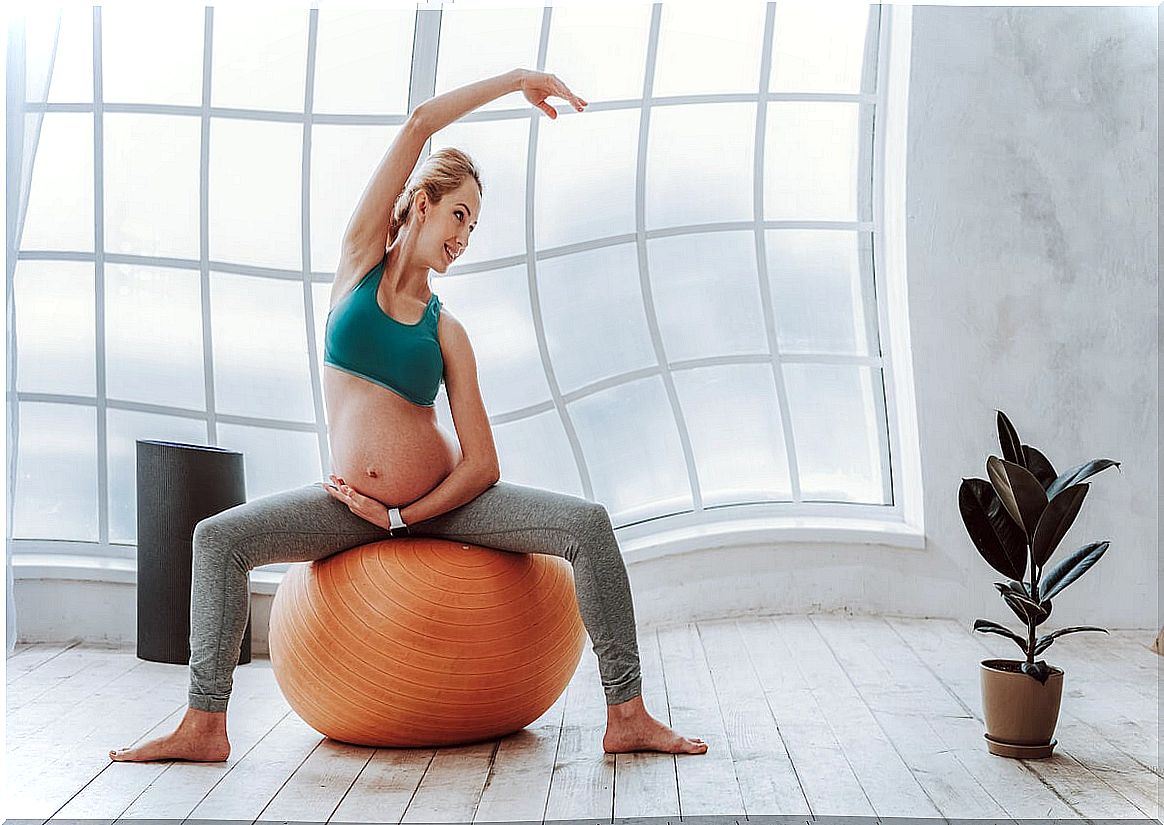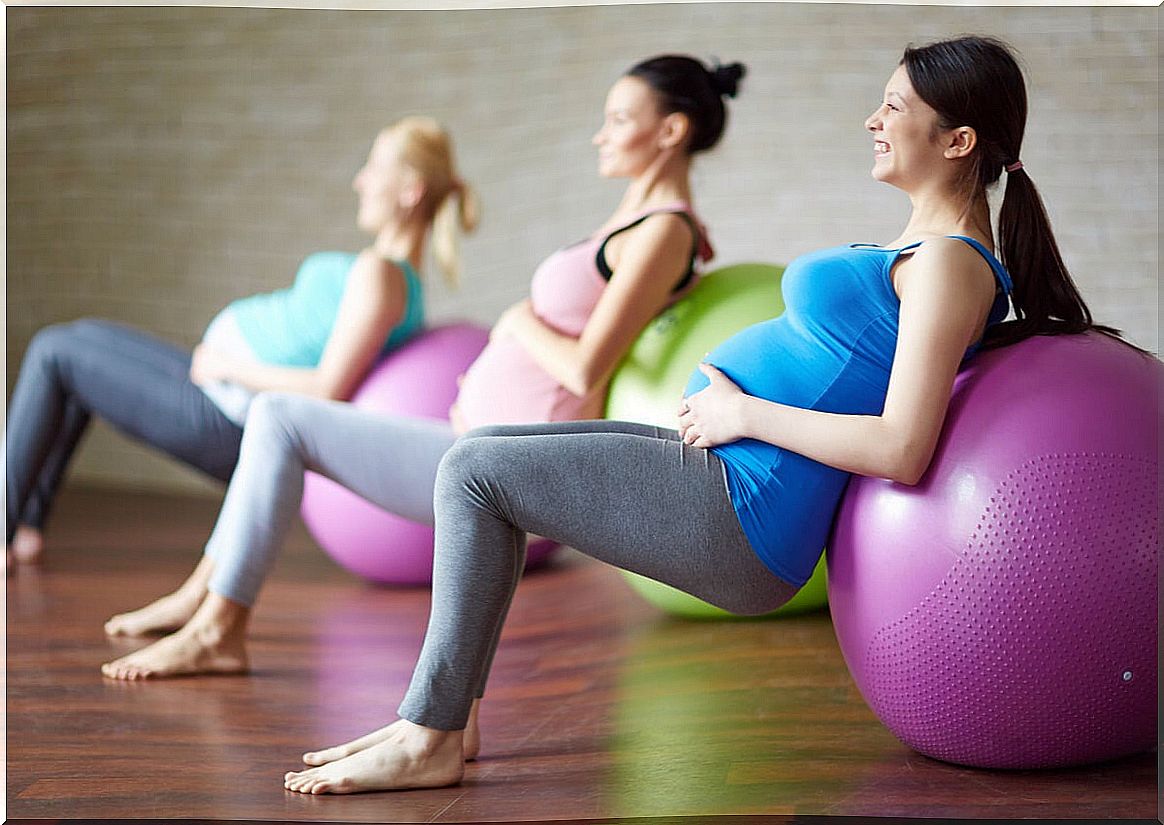Ball Exercises For Pregnant Women
Incorporating a ball into your training routine during pregnancy strengthens the pelvic floor and reduces back pain. Learn about the exercises you can do to get these benefits.

More and more women with children affirm the benefits of doing exercises with a ball while they are pregnant. It turns out that the more active and fit you are, the less hard it will be to cope with the psychological, shape and weight changes that pregnancy entails. Unless directed by your obstetrician, you can maintain your quality of life by exercising.
Exercises such as yoga and Pilates will help you maintain correct body posture, as well as combat exaggerated weight gain. They can also be a palliative for the usual discomforts of pregnancy, such as constipation.
But this is not all. Physical exercise is just as beneficial for the mother as it is for the fetus. Babies whose mothers exercised during pregnancy have a more stable heart rate during and after pregnancy, in contrast to sedentary mothers. Find out which are the best ball exercises for pregnant women.
Benefits of exercising using a ball for pregnant women
Incorporating a ball into your exercise routine during pregnancy is beneficial to strengthen the pelvic floor and reduce back pain that occurs throughout pregnancy.
Preventing weakness during pregnancy helps the pelvis withstand the weight gain and pressure from the baby’s growth during pregnancy. In addition to avoiding the aggravated incontinence that many women suffer in recent months, due to the pressure of the baby on the bladder.
Similarly, if you plan to have a natural delivery, Swiss ball exercises can help you avoid a prolapse of the uterus or other abdominal organ. In the same way, the risks of tears and diastasis are reduced, so your postpartum recovery will be quick.

Exercises for pregnant women using a ball
Prenatal ball exercises can reduce the risk of an unplanned C-section and increase the flow of oxygen in your body and the baby’s. Discover 6 ideal ball exercises for pregnant women.
1. Arms and waist
Begin with gentle rotary movements to warm up your shoulder, hand, knee, ankle, and hip joints as you breathe deeply through your nose. Then gradually exhale the air through your mouth.
- Stand upright and make sure they are slightly apart and flat on the ground to ensure stability.
- With both hands, grab the ball and carry it just above your head, with your arms well stretched.
- While you are in that position, make gentle circles with your torso and go lowering the ball, from your right side to the waist, and then raise it up your left side while still moving your torso.
- Perform the movement 5 times and reverse the direction of the exercise. Run it 5 more times.
- After the routine, return to the starting position, then bend your knees and move your hips forward a little. Now turn your torso to the right and then to the left; This movement is ideal for stretching your back.
2. Stretching and abductors
Unlike other exercises, sitting on the ball puts your hips above the knees, which helps reduce pressure and improve baby positioning.
- With your legs spread, sit on the ball.
- Make sure your back and head are straight, while with a firm movement you slide to your right side, bend the knee to 90 degrees and the left leg is extended.
- Hold the pose for about 30 seconds and perform the movement in the opposite direction. You can place your hands on your hips or legs to ensure better balance. Do two sets of 3 reps.
3. Pectorals
The instability that the ball provides forces you to rectify your posture, so you will have to apply force with your quadriceps and in turn tone the involved muscles.
- Get on your knees and then firmly and securely support both hands on the ball.
- Now lean your body forward and let your weight fall on the ball and very gently and safely take your feet off the ground, leaving only the balls of your feet in contact.
- Then execute some semi-flexions maintaining the posture described, but being very careful not to let go of the ball and slip.
4. Abs
This exercise is ideal as a palliative for back pain, especially lumbar discomfort, since your position is relaxed and reduces pressure.
- Lie on your back on a mat on the floor.
- Now place the ball in the middle of your legs, at the level of the knees.
- Then raise your legs, without letting go of the ball or taking your hips off the ground.
- Go down gently and back up. Perform 4 sets of 4 reps, taking short breaks between sets.
5. Pelvis and hip
This exercise is recommended to strengthen your pelvic floor, a necessary condition for a healthy delivery and postpartum.
- On a mat on the floor, lie down facing the ceiling and with your knees bent.
- Place the ball between your legs, then raise your pelvis and, with your pelvis and legs elevated, squeeze the ball.
- Lower your legs. Repeat the movement 5 more times without stopping squeezing the ball or coming to rest touching the ground.
6. Buttocks and thighs
Ball exercises improve the flexibility of your spine and your pelvis, so that when you sit down the discomfort in the groin area is significantly reduced, in addition to toning the buttocks.
- Get on your knees in front of the ball, hold it with both hands.
- With your back straight and looking straight ahead, stretch one of your legs. Make sure it is in line with your back.
- Now perform small lifts above the horizontal, while squeezing the glute. After 5 reps, switch legs.
- Incorporate these exercises into your routine two to three times a week during pregnancy.

Exercises or movements to avoid
If you are an active athlete, you should modify your routines with less impact exercises during pregnancy. Both pregnant athletes and sedentary women apply the same advice, unless the doctor indicates otherwise. The following should be avoided:
- Exercises that require sudden movements of lowering, raising, bouncing or changing direction.
- Activities in which the abdominal area is exposed to receiving a blow.
- Exercises that involve large weights.
Recommendations for exercising during pregnancy
The safest stage to start physical activity during pregnancy is from the fourth month. This is because in the first trimester there is a certain risk of miscarriage.
Before incorporating exercises for pregnant women into your daily routine, inform your obstetrician of your intentions, as there may be some contraindications. Especially in high-risk pregnancies or if symptoms occur when practicing any exercise, such as dizziness, shortness of breath, chest pain and bleeding.
Finally, use the necessary safety measures, such as having a snack an hour before the routine, wearing a pelvic belt if necessary and making sure that your ball is designed for pregnant women.









